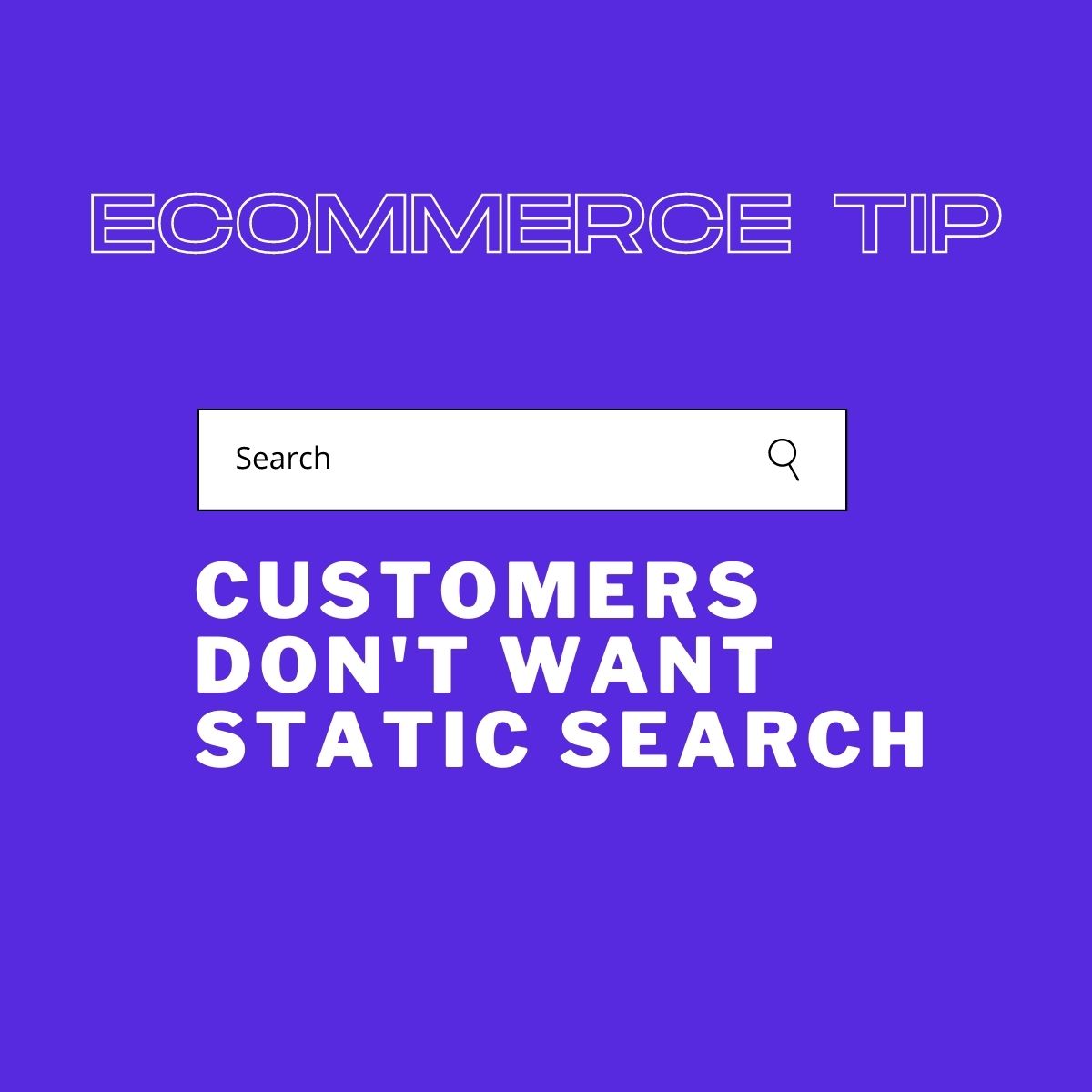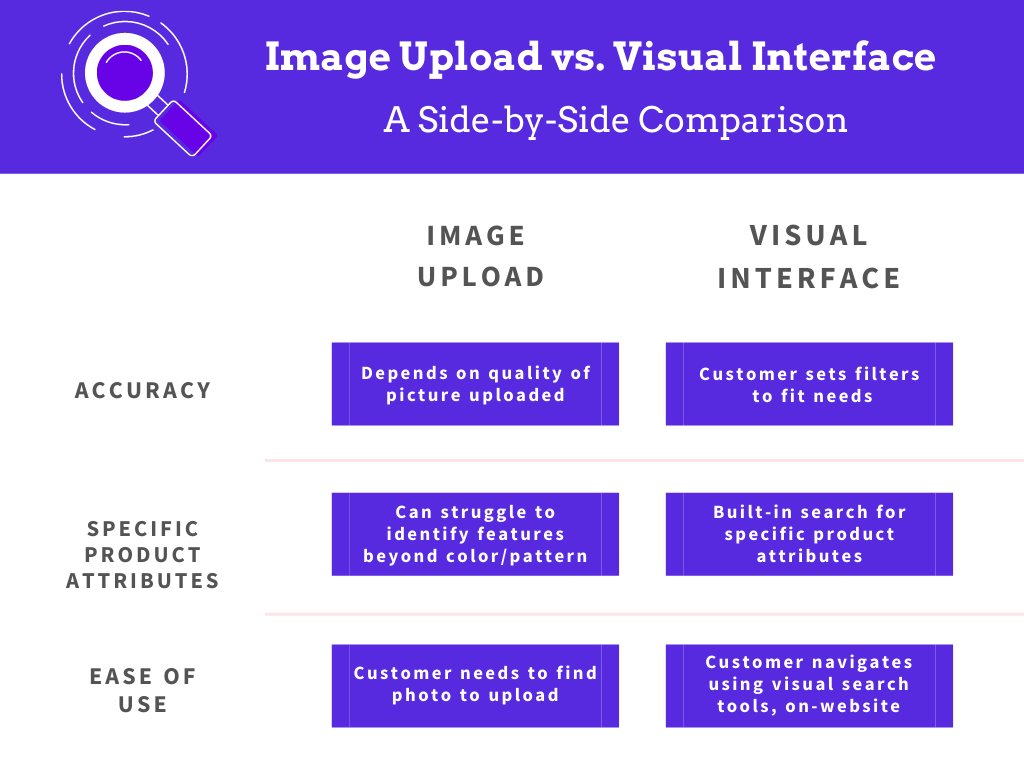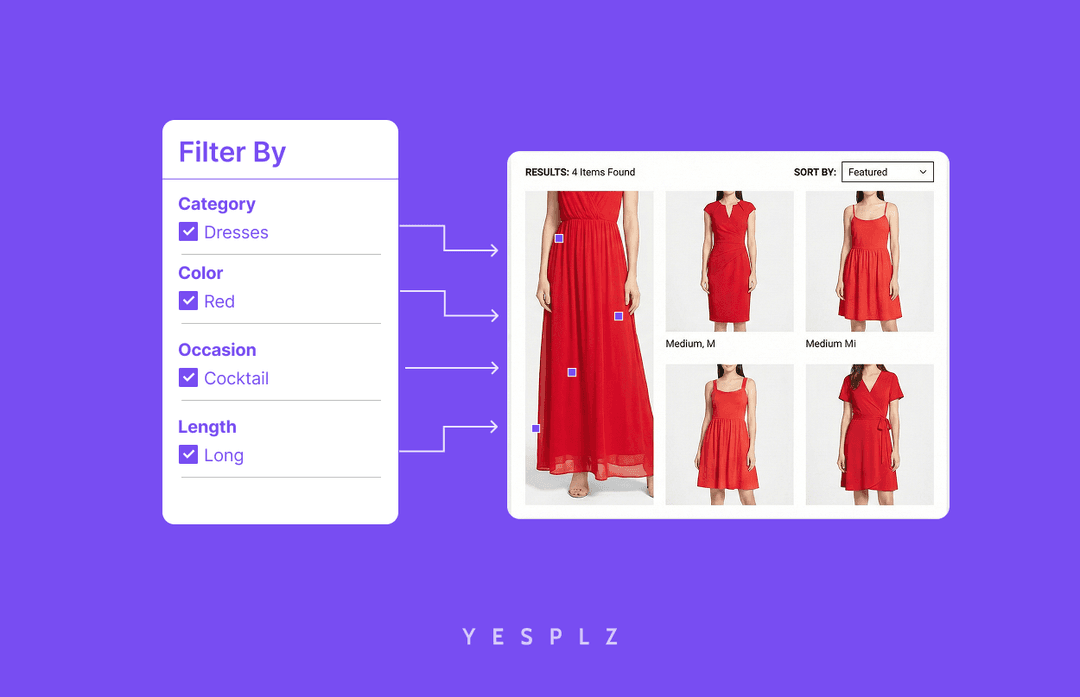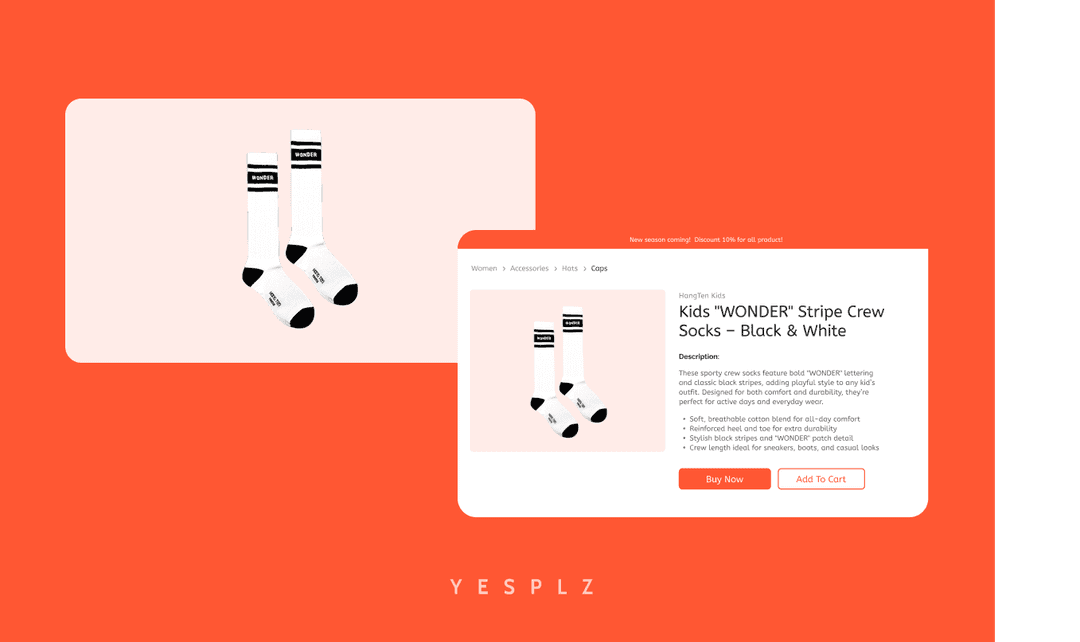A Comprehensive Explainer
by Jess Erdman, Content Marketing LeadAugust 2021

Most online retailers are aware that shoppers value a seamless search experience. In fact, search experience can be the deciding factor between customer loyalty and cart conversions.
Search and navigation is consistently ranked as the most important attribute of the eCommerce experience.
But, not all search experiences are the same. There are considerable differences between types of search, including visual versus text.
When a shopper uses text-based search, she is tapping into a complex web of fashion taxonomy to find a product.

For example, if she is looking for a pair of high-end trousers, what should she type into the search? There are a number of options:
-trousers
-dress pants
-slacks
-office pants
….and the list goes on…
While all of these are technically correct terms to find a pair of trousers, depending on the keywords your store uses, she may end up with a “results not found” page.
When shoppers don’t find what they want, they aren’t willing to try over and over--they’ll simply leave your page to an easier-to-navigate website.
In this guide, we’ll discuss the different components of visual search and search clothes by image, and the implications for your eCommerce.
Search doesn’t need to be difficult.
Text-based search comes with a number of problems for eCommerce:
It leaves customers frustrated, without relevant search results.
At the root of the problem is accuracy. Without accurate search, shoppers that search for “dress pants” might end up with a mix of search results that include dresses and pants--because text-based search has difficulty recognizing search intent.
To learn more about customer search intent, and how to identify different types of eCommerce searches, check out this guide.
When customers have access to accurate search results, they’re more likely to complete purchases and become repeat customers. But, if text-based search isn’t meeting customer needs.
Enter visual search, or search clothes by image. More and more eCommerce stores are considering search clothes by image because of its clear benefits. In this article, we’ll break down how search clothes by image can increase search accuracy and why that matters for your eCommerce store.
But, what makes search clothes by image interesting is the underlying technologies.
You’re likely familiar with camera search as a visual search function on major retailer websites such as H&M or Asos. In theory, it’s simple--users upload a picture of their desired product and artificial intelligence works to find relevant search results from the eCommerce store.
Curious to go in-depth on visual search? We have an easy comparison for you to learn about different types of visual search here.
While camera search was a great start and began a movement to innovate the search experience, it’s certainly not the end of the journey.
Camera search is when a user uploads a picture of a product, and artificial intelligence finds similar retailer products.
Camera search gave shoppers the ability to search clothes by image, but missed the opportunity to allow shoppers to do what they love: find their favorite fashion attributes such as fit or cut.
Camera search is great, but has disadvantages for customers who want to customize their search further--they may be limited by the picture they uploaded. Perhaps the picture has some aspects of the product they’re looking for, but not everything.
It’s exciting for a shopper to search clothes by image, but they need more--and that’s where other visual search methods enter the picture.
Beyond camera search (or image upload), there’s visual interface search. Visual interface is a type of visual search, but is customizable based on customer preferences. You can find an in-depth explanation of visual search and search clothes by image here.
The YesPlz Style Filter is an example of visual interface search. Customers can visually filter clothing using a mannequin, and receive accurate search results based on the selected filters.
The YesPlz Style Filter uses artificial intelligence trained to understand customer fashion preferences, and pulls relevant results based on how the customer wants to filter:
The difference between visual interface and camera search (image upload) can be vast depending on the tool:

Here’s how search clothes by image can make searches more accurate and interactive for customers:
Why this is important: Depending on the type of underlying technology, customers can form in-depth search queries with just a few clicks.
Based on the research we conducted at YesPlz AI, we learned that customers have an idea of which body parts they want to show off,and which body parts they want to hide. Therefore, when searching for a simple t-shirt, a customer may want to hide her shoulders or stomach.
When using text-based search, a customer will need to type in a string of keywords to search, such as “loose-fitted, long white t-shirt.”
However, what if the customer types “loose fitting” instead of “loose fitted”? The search engine may not recognize her search terms, and she’ll be forced to make more general search queries such as “white t-shirt”--without being able to filter for the fashion attributes she values.
Takeaway: Search clothes by image gives customers the power to search and filter for important fashion attributes at the same time.
Why this is important: Let’s face it--shopping online can be tedious for most customers. There’s something cold and impersonal about shopping online--and customers miss the opportunity to connect with the products.
In-store, customers would touch and engage with a product to see whether they’re interested in purchasing--but online, that experience is missing.
When customers have the ability to search clothes by image, the shopping experience is transformed. The search experience goes from static to interactive, and with some visual interface tools, even mimics the in-store shopping experience.
Takeaway: By giving customers a new way to explore and discover products, search clothes by image has the potential to attract more customers and encourage repeat purchases.
If you’re looking for more tips for how to implement visual search, check out our article on visual search filters, which has 3 quick tips for eCommerce.
We live in an exciting time, where eCommerce has the ability to pull from new fashion tech trends. As visual search moves beyond camera search and into more complex types of search, customers will be empowered to find the products they’re looking for, without having to type in multiple search terms or continuously filter.
Before implementing visual search for your eCommerce, it’s vital that you reflect on the tool and how you’ll implement new technology. We have some tips for you if you’re considering new visual search tools.
Most importantly, visual search and search clothes by image has proven its value to customers and retailers. Is your eCommerce ready to try a new visual search tool?
Written by Jess Erdman
Content Marketing Lead
I'm passionate about creating cool content. The best part? I get to learn new things about fashion tech and ecommerce everyday. Have an idea or opinion about this article? Reach out at jess@yesplz.ai

Stop losing sales to poor product filtering. Discover how AI simplifies creating Shopify filters, saving you 25-50 hours per 100 products.
by YesPlz.AI

Automate Shopify product pages and cut 50–100 hours of manual work. AI generates product titles, descriptions, and metadata instantly from product images.
by YesPlz.AI